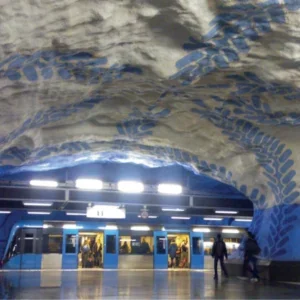Terminal 5 is one of the largest construction developments in Europe today; with a monthly spend of about US$150.2M and a total estimated outturn cost of US$7.9bn. In 2008, Terminal 5 (T5) will provide London’s Heathrow Airport with an additional capacity of 30M passengers each year, giving Heathrow a capacity of around 90M passengers per year. Approximately 14km of tunnelling will provide road and underground rail links to the Terminal. The tunnels consist of a 4.1km, 3m diameter stormwater outfall tunnel and three tunnels connecting the airport to T5. These are: the Piccadilly Line Extension, some 1.7km of 4.5m diameter expanded concrete segmental lined twin bore tunnels; the Heathrow Express Extension, approximately 1.6km of 5.7m diameter expanded concrete segmental lined twin bore tunnel; and the Airside Road Tunnel (or ART tunnel), 1.3km of 8.1m diameter segmental lined twin bore tunnel.
Whilst the majority of the tunnelling has been carried out using TBMs, innovative developments of a single shell shotcrete lined tunnelling method, called Lasershell (T&TI, June 2003, p38), were used for the construction of the numerous short complex underground structures associated with the underground development.
To deliver this project BAA put together a single, multi-company integrated team which included for the tunnelling works: BAA, the Client; Morgan Vinci who constructed all the tunnelling works; Laing O’Rouke, who constructed the portal and civil works for the Airside Road Tunnel; Amec, who designed and installed the electrical and mechanical aspects for the Airside Road Tunnel; Mott MacDonald, who were the overall civil and tunnel designer for the tunnels; and Beton-Und Monierbau, who carried out the Sprayed Concrete Lining (SCL) design and provided on site specialist support.
Managing project delivery risks
Reflecting on recent major tunnel collapses such as Heathrow (1994), Munich (1994) and Nicoll Highway (2004), Williams explained that managing tunnel delivery risks is a key element of any major tunnel project. However this was particularly relevant for Heathrow, considering the range of infrastructure that exists above the main tunnel drives, including railway tunnels, key Thames Water facilities and the world’s busiest international airport.
In the 1990’s BAA appreciated that to build a project the size of T5 a new approach was necessary and that the key to success would be a non-adversarial contractual approach based on relationships and behaviours, rather than transactions with cost reimbursement as a principle cornerstone of the contract. To achieve this, suppliers’ actual costs would be reimbursed with a guaranteed element of profit and an incentive target payment, to reward exceptional performance if achieved, would be split between all parties, including BAA. This was embodied in the T5 Agreement that focuses on principles such as behaviour and risk management rather than contractual positions. It also focuses on performance and success rather than failure, and on people as individuals in integrated teams not suppliers. The Agreement is the same for all and importantly contractual risks of cost and programme are not shared, they are held by BAA.
Because BAA carries all the risks, the main tool in the management of risk is fully-integrated team of BAA and its suppliers focusing on solutions and risk management. Ground movements were considered one of the major risks and therefore the monitoring and control of ground movement was a key part of the risk management strategy.
Airside Road Tunnel (ART)
The ART project passes beneath airport infrastructure and above the existing Heathrow Express running tunnel between Terminals 3 and 4. To minimise settlement the ideal tunnelling horizon was the London Clay, but at the portals there was a high potential that the crown of the tunnel might encroach into the Terrace Gravel. Here, to maintain settlement below 25mm a face confinement pressure of 1.5 to 2 bar would be necessary.
There were also constraints on route selection including the limited points for a portal, the crossing of the Heathrow Express tunnel mid way along both drives and the desire to avoid, where possible, main taxiways and buildings. The design gradient and the potential increased depth ruled out going beneath the existing Heathrow Express tunnel therefore the resulting horizontal alignment gave a W profile with the portals and the Heathrow Express being high points in the tunnel with two low points either side of the crossing.
To achieve the 2 bar confinement pressure two options were considered: (1) EPB where the clay would be turned to paste in the chamber or (2) a method, more traditionally employed in London Clay, the application of low pressure compressed air.
It was considered that mechanical excavation with air pressure alone would not support the face effectively if the Terrace Gravels were encountered, therefore the Team with Herrenknecht developed a 9.18m diameter closed face TBM with low air pressure capability to make best use of the clay’s impermeability. The TBM could operate with a partially filled chamber under compressed air in normal conditions and in the event of encountering granular material had the capacity to convert to EPB mode.
Tests confirmed that London Clay would not form a plug in the screw, reliably maintaining 2 bar pressure, therefore a mechanical method of maintaining pressure had to be developed. Following a significant development and testing programme, a Putzmeister twin piston pump screw conveyor airlock system, consisting of two 750mm diameter pistons with an output of 400 tonnes/hour was fitted to the end of the screw conveyor. This allowed material to travel along the screw conveyor and then drop into the pump, where its two piston pumps acted as airlocks to control the air pressure in the chamber of the TBM.
Other features incorporated into the TBM to aid the control of ground movement included: (1) keeping the cutterhead within the extrados of the TBM so that the front edge of the shield acted as a cutting edge; (2) limiting the conical shape of the TBM; (3) bentonite injection around the tailskin to provide ground support and maintain the face air pressure and (4) simultaneous automated pressure controlled tailskin grouting.
Despite having the appropriate TBM and tunnel alignment, ground movement was still inevitable, therefore a ground movement management system and monitoring process was developed to manage risk to all stakeholders. An outline of the steps taken within the process are shown in Fig 2, with the monitoring cycle being repeated until such time that readings were static and the works completed.
Ground movement results
Besides the airport infrastructure, one of the specific high profile challenges on the ART project was the crossing over of the Heathrow Express tunnel. The crossing was located about halfway along the drives. The particular challenge was the low cover of 7.4m to the surface above the TBM and only 3m beneath the TBM to the existing tunnel.
The objective was to drive the TBM without affecting the Heathrow Express. The instrumentation ranged from survey pins on the track to remote monitoring linked to the site offices monitoring the trackbed and tunnel lining for distortion and bodily movement.
The graphs in Figure 3 shows, for two sets of data, the relationship of the distance between the track level and the tunnel crown relative to the passing of the TBM. The data (Figure 3a) shows that as the TBM approached the Heathrow Express tunnel elongated slightly, by about 1mm, and when the TBM was crossing above the deformation in the tunnel reversed and the tunnel started to squat, by about 5mm, then immediately after the TBM had passed the tunnel again elongated, but not quite to its original position, leaving an overall movement of about 2mm. Figure 3b shows the horizontal movement which was opposite to that recorded in the vertical direction. The final movement was about a 1mm increase across the tunnel diameter. To put the movement into perspective, the TBM passed over the Heathrow Express tunnel twice without affecting its operation and the overall movement recorded was less than 10 times any trigger level.
The settlement over the centreline of both tunnel drives was controlled such that for over 36% of the drives movement was between -5 and +5mm, for 90% of the drives the movement was in the range of -10 to +10mm and no settlement was over 20mm. Overall the calculated face loss was only 0.35%.
Heathrow Express and Piccadilly Line Extensions The HexEx and PiccEx tunnel extensions cross beneath the Piccadilly Loop line, work adjacent to the Heathrow Express and step plate junction tunnels.
The most sensitive of these were the crossings of the Piccadilly Loop tunnels. Figure 4 shows the most critical element – long undulation. The graph shows the actual undulation relative to the trigger limits, which are the lines coloured blue, yellow and red. The apparent roll in the graph is as a result of the tunnel passing beneath at a skew angle. The actual undulation was less than 5mm, which was within the Green Limit specified.
To summarise, none of the control trigger limits were exceeded for any of the three crossings and the Emergency Preparedness plans were deactivated within 48 hours of completing the crossings.
Managing safety – Lasershell tunnels
The Lasershell method was developed to improve safety by eliminating the need for miners to enter an unsupported face area and to mechanise the process to reduce injuries. Key in the development were last ring closure with minimum joints in the shotcrete lining and its suitability for complex structures.
The basic concept of Lasershell is a circular cross section with an inclined domed face and rapid shotcrete ring closure. All excavation is carried out by machine and the shotcrete has a permanent load function, with no girders or mesh, no horizontal joints and only one circumferential joint. A finishing layer is applied behind the main tunnel advance.
Shotcrete mix design included rigorous testing for strength, durability, permeability and behaviour under load before the workability of the shotcrete. Subsequent trials of the mix gave an opportunity for the nozzlemen to be trained to a high competency level. Lattice girders are not used to aid shape control with Lasershell as the TunnelBeamer survey tool guides excavation and spraying.
Summary
The single Team has constructed 14km of high quality, incident free tunnels. Methods and processes have been developed to address the risks associated with tunnelling beneath the infrastructure of the world’s busiest airport and to cross the Piccadilly Loop Line and Heathrow Express Tunnels without effecting their safe operation. Overall the project has been delivered to programme and within budget.
Related Files
Figure 2
Figure 4
Figures 3a and 3b






